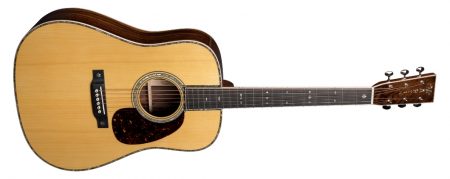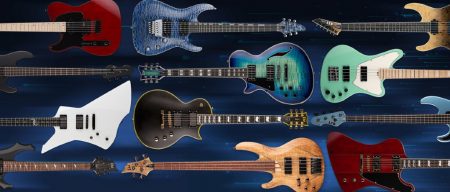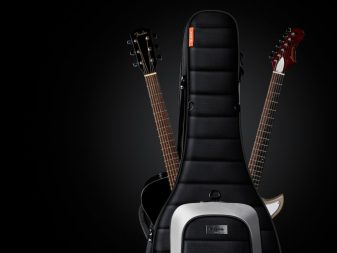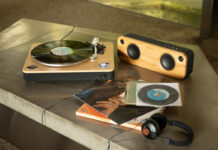 The guitar is one of the most versatile instruments around. It covers many various musical duties: rhythm, harmony, melody and you can even accompany yourself while you sing. Combined with the fact that it’s highly portable, what you get is the ultimate entertainment tool. If you are interested in checking out this world of possibilities, you might be overwhelmed by the wealth of choices and specifications related to the guitar. We created this guide to help you learn about guitars so you can make the best purchasing decision for you and your family.
The guitar is one of the most versatile instruments around. It covers many various musical duties: rhythm, harmony, melody and you can even accompany yourself while you sing. Combined with the fact that it’s highly portable, what you get is the ultimate entertainment tool. If you are interested in checking out this world of possibilities, you might be overwhelmed by the wealth of choices and specifications related to the guitar. We created this guide to help you learn about guitars so you can make the best purchasing decision for you and your family.
Table of Contents:

Types of guitars
The image above shows three of the different types of guitars that will be covered in this section: an electric, a 12 string acoustic, and a six string acoustic. There are several families of guitars, each having subdivisions of their own. It’s important to grasp the base concepts when first starting out, to develop familiarity and comprehend the effect on the sound. Your musical preferences will also definitely influence your choice of guitar type.

1. Acoustic guitars
The six string acoustic guitar is the most common guitar for first-time buyers. Countless legendary songs have been composed on one of these and it still continues to inspire many new artists for their creations. This steel-stringed instrument is a perfect place to start your musical journey because of the immense catalog of musical material available to it, from pop repertoire to difficult technical exercises that will push you to become a better guitarist and musician.
An acoustic guitar is a self-amplified instrument that comes in a variety of sizes. The most common shape is the Dreadnought, named after the Martin guitar of the same name. There are other proportions available such as the OM, Jumbo, and Parlour. While these provide certain different tonal characteristics, if you are looking at a first guitar, the Dreadnought is likely the best all-around choice. Some manufacturers offer smaller scaled guitars that include ½ and ¾ guitars: these are often preferred by younger players. Despite a smaller size, many of these have a rich tone and are used by professionals (e.g., Ed Sheeran uses a smaller guitar). Jasmine has a wide variety of guitars that are affordable and well-made and are great for beginners.
2. Acoustic-Electric Guitars
If you plan on performing with an acoustic guitar, the easiest way is to get one that you can plug in to an amplifier: these are often called acoustic-electric guitars. Many models are shipped with an integrated pickup system. Manufacturers actually offer two versions of their models, one with electronics and one without, so make sure you know which kind you want.
Epiphone has many different guitars that are based on legendary Gibson models and that include integrated pickups. Amongst these is the very popular Hummingbird which was used famously by The Rolling Stones, Sheryl Crowe, and Chris Cornell.
3. Nylon/Classical guitars
These guitars follow the same basic concept as acoustic guitars: a self-amplified instrument. The major differences lie in the neck shape and, especially, the fact that they have nylon strings instead of steel ones. This plays a major role in the tone of the guitar and it produces a very warm and soothing timbre. You’ll most likely encounter these guitars in classical and world music, but they sometimes make an appearance in pop, rock and even metal.
A distinction is often made between a classical and a nylon-string product. This is because the classical variant usually follows traditional building principals while the nylon-string might make use of more modern concepts.
Nylon stringed instruments have often been recommended for beginners because they offer a painless playing experience, something that can be bothersome on the steel-stringed models. However, the neck is wider, so younger players will definitely benefit from using a smaller scale design.
4. Electric guitars
 The electric guitar has immensely shaped the way music is written and produced in the last seven decades. Its immense tonal variances have enabled creative musicians to create textures that are sometimes so different from one another, that it is hard to believe that they come from the same instrument. This extremely versatile tool is what you get in an electric guitar.
The electric guitar has immensely shaped the way music is written and produced in the last seven decades. Its immense tonal variances have enabled creative musicians to create textures that are sometimes so different from one another, that it is hard to believe that they come from the same instrument. This extremely versatile tool is what you get in an electric guitar.
5. Basses
 For those that love the low end of the sound spectrum and insuring that the music has a stable, reliable accompaniment, the bass is the perfect tool. Basses traditionally have four strings, but some models extend the lower range with a fifth string. There’s nothing like hitting those sub-bass tones in any style of music. If you are a complete beginner, you might benefit from making things as simple as possible and limiting the number of strings to the traditional four.
For those that love the low end of the sound spectrum and insuring that the music has a stable, reliable accompaniment, the bass is the perfect tool. Basses traditionally have four strings, but some models extend the lower range with a fifth string. There’s nothing like hitting those sub-bass tones in any style of music. If you are a complete beginner, you might benefit from making things as simple as possible and limiting the number of strings to the traditional four.
How to choose the right guitar
Things to consider when selecting your first instrument

Once you’ve picked a type of guitar, it’s then just a matter of finding the ideal model for you. Big guitar manufacturers such as Yamaha, Epiphone, and Gibson offer all types and represent excellent value for your money. For example, Yamaha’s C, FS and FG series are extremely popular nylon and acoustic lines that you will find in households and classrooms throughout the world. Their solid construction also holds up very well to our particular Canadian climate for years of playing enjoyment.
If you are going the electric guitar or bass route, Kramer has traditional S-type guitars that have great value for the money. Epiphone by Gibson offer various bundles of their most popular models.
The great thing about electric instruments is that they are easily upgradable and you can always find a use for them. Here are a couple of things to consider about electric guitars:
Key consideration #1: pickups One of the biggest factors to consider is if you want a single coil guitar (such as a Stratocaster) or a humbucker guitar (like a Les Paul). These terms refer to the number of coils the pickups on the guitar possess. Humbuckers are more powerful and full sounding than their single coil counterparts and go well with more gain. This is great if you are interested in distorted sounds, such as rock and even heavier music. Single coils, on the other hand, are great for pop, country, and blues, thanks to their brighter, jangly tone. Often watching the choices made by your favourite artists can help you decide which type is right for your musical tastes. If you are unsure, there are guitars that incorporate both types of pickups in the same guitar. The fat strat (and all its offshoots) is a perfect example of this.
Key consideration #2: bridge type Some electric guitars have a floating tremolo which helps you add a lot of different inflections to your notes and riffs (pull up or down on the tremolo bar to bend the notes higher or lower). The downside is that the bridge tension has to be positioned to an exact setting, so you can’t easily change tunings without seriously compromising the stability of the tuning: it may have trouble staying in tune. Additionally, if you go to a lower tuning, therefore lowering the tension on the strings, the bridge will sag and greatly affect your playing experience. A fixed bridge avoids this problem, but takes out the possibility to play with the pitch using the tremolo.

How to choose your second guitar
If you are already comfortable with the basics or you are shopping for a second guitar, it’s time to look at what you are missing. For example, if you have a fixed bridge on your electric guitar, it’s a perfect opportunity to check out a floating tremolo unit. There will be many new things to learn and to experiment with.
Additionally, if you have a single coil guitar, you might want to explore the soundscapes available with humbuckers, or vice versa. New doors will open to you and it’s an interesting experiment to see how much your impression of the instrument will change. If you gradually build up your options, you will easily find motivation to practise and try novel techniques. This will lead to a more complete understanding of the guitar, making you a better player and musician.
Two great instruments exist that really complement each other; the Stratocaster and Les Paul. These instruments have been featured in all styles and you will never run out of music to play with them. Other essential models include the Telecaster, SG and more modern concepts by Jackson, Ibanez and ESP made for technical playing.
If you are more of an acoustic player, you can definitely complement your steel string acoustic with the mellow tones of a nylon-stringed model and vice versa. Also, there are many different acoustic shapes to look into. OM shapes provide an excellent singing tone that really lends itself to singer-songwriter situations and intricate fingerstyle. Jumbos provide a huge sound, perfect for riveting strumming. Parlour guitars produce a soft intimate sound: silky chords and singing melodies. Lastly, the twelve string guitar adds a different dimension and fullness to playing thanks to doubling up each string, with some of them tuned an octave higher.

High end guitars: factors that can affect the price
When it comes to the high end of guitars, you are usually paying for the expertise of the builder, the quality of components and location of the factory. American and Japanese-made instruments fetch a topmost price because they are undertaken by highly qualified personnel working with choice woods, the best components, and very involved designs.
Instruments that feature things like an arch top, set necks and rare woods also inflate the price tag. Sometimes these features are more for comfort or looks than actual sound improvement. Take the time to understand what you are paying for and if you need it.
 That being said, high quality instruments present several advantages. First of all, they are very steady. A lot of research has gone into treating the wood so that it stays stable, staying in tune and presenting a consistent tone over years, no matter the environmental conditions. Secondly, they usually have the best possible resale value, so if ever you feel like you need a change, you can trade or sell it for another high-end model without too much of a hassle.
That being said, high quality instruments present several advantages. First of all, they are very steady. A lot of research has gone into treating the wood so that it stays stable, staying in tune and presenting a consistent tone over years, no matter the environmental conditions. Secondly, they usually have the best possible resale value, so if ever you feel like you need a change, you can trade or sell it for another high-end model without too much of a hassle.
Last but not least, these types of instruments have an intangible factor to them. If you ever played such a guitar, you’ll know that mojo is very important in music creation. There is something about an instrument that screams back when you yell at it, that cries when you sing to it and that evokes emotions when you paint with it. While all of this might seem ethereal, it’s an unexplainable feeling that you get when you use something that was crafted seemingly for you. Eventually, all players deserve this type of relationship.

Guitar accessories every one should have
Here are some the standard accessories most guitarists own (in no particular order):
1. A good case will help you carry your guitar safely from one location to another. If you don’t plan on doing long distance travelling, a soft case is more than enough. These are light and usually feature shoulder straps for hands-free movement. Otherwise, a hard case is a good investment to protect your precious investment, especially if it’s a more expensive item.
2. A good tuner is also essential. Even though it’s important to develop your ear and learn to tune to a simple reference tone, it’s always good to double check your pitch with a dedicated tool. This will not only help with your hearing acuity, it will provide a pleasant, harmonious playing experience for you and whoever is close-by.
3. Extra strings on hand. A few packs can help you keep the music alive if you happen to break one. Changing strings isn’t hard at all and many excellent resources are available online.
4  Other essentials include: straps for comfort either sitting down or standing up, a guitar stand to have quick and safe access to your instrument and a variety of picks (they are very easy to lose). Also, almost every guitarist owns a selection of capos: these allow you to press down all strings higher up the neck, altering the tuning of the whole instrument. For example, if a song is in C, you can put the capo on the third fret and play it in A for a different feel and tone, though it’s in the same key.
Other essentials include: straps for comfort either sitting down or standing up, a guitar stand to have quick and safe access to your instrument and a variety of picks (they are very easy to lose). Also, almost every guitarist owns a selection of capos: these allow you to press down all strings higher up the neck, altering the tuning of the whole instrument. For example, if a song is in C, you can put the capo on the third fret and play it in A for a different feel and tone, though it’s in the same key.
If you go with an acoustic instrument, some kind of humidifying product will keep your guitar in great playing condition year-round. With the dry, heated air wreaking havoc on necks, soundboards, and bodies during the winter months, it’s better to anticipate and save you a lot of trouble and heartache if something goes wrong. These can help maintaining the integrity of your electric instruments also.
Hopefully, this guide has cleared up some of the peculiarities of the guitar world. There’s nothing like trying out many models for yourself and analyzing how you work with a particular instrument. Make sure you check out all the different guitars available. Best Buy has many of them from some of the most renown makers.
Take the next step
 Take a look at all the guitars and accessories available on Best Buy’s website.
Take a look at all the guitars and accessories available on Best Buy’s website.



